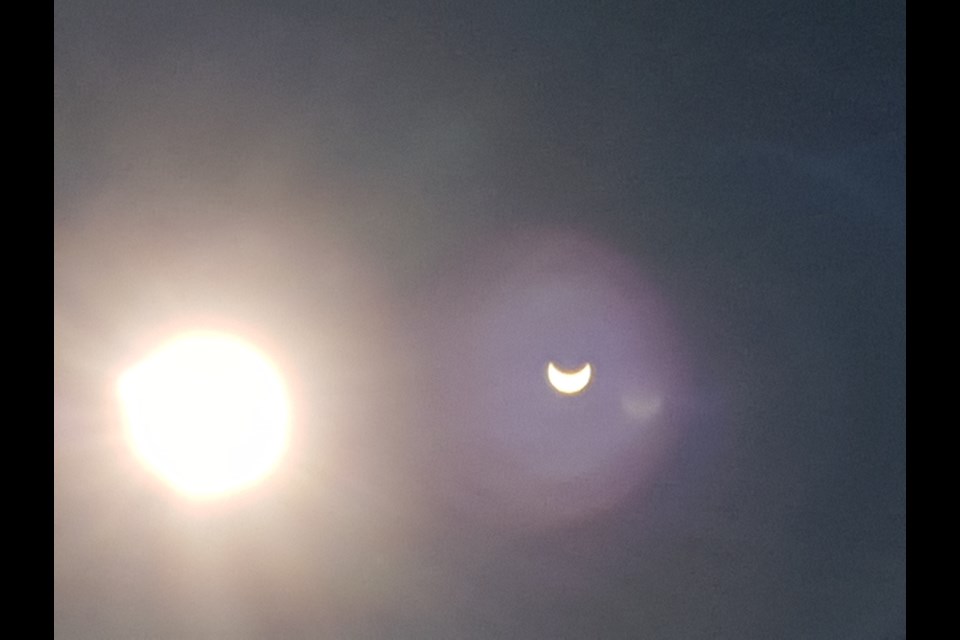A crowd well over 100 and possibly reaching up to 200 gathered at Gillies Lake Monday afternoon to participate in a guided viewing of the partial eclipse hosted by Science Timmins and the Timmins Astronomy Club.
A line up snaked its way from the Science Timmins tent towards the Mattagami Conservation Authority building waiting to obtain specially designed eclipse glasses that were being handed out for safe viewing.
“I was expecting 100 people to show up,” said Antoine Garwah from Science Timmins and Timmins Science Village, as he was handing out the glasses and asking the crowd to share the glasses with others who came to watch the eclipse.
“The good weather and the media coverage of the solar eclipse, both locally and across Canada and the United States, helped increase the numbers,” said Garwah
Jayson Hoffman of the Astronomy Club was helping people view the eclipse at one of three telescopes set up for the occasion.
“Pretty good crowd considering a local radio station was advising people to stay home and watch it on television or via the internet, because looking at the eclipse would hurt their eyes.” Hoffman said.
Despite the caution, many still turned and used a variety of safe viewing methods to watch the eclipse arise and withdraw over a period of about one hour and 45 minutes.
The Astronomy Club provided several telescopes with safety approved filters to get a closer look.
On the telescope that Hoffman was supervising, the filter on the lens turned the magnified image of the sun bright orange.
At 1 p.m. the moon's shadow began to nibble at the edge of the sun. By 1:30 p.m., a third of the sun was in shadow.
“The partial eclipse here in Timmins is expected to cover about 60-65 percent of the sun,” explained Hoffman.
The crowd both young and old lined up at three Astronomy Club telescopes to view.
Mothers with young children in elementary school, high school students and even out of town guests like Gerri Mathewson from Hornepayne took a peek at the partial eclipse.
The maximum extent of the partial eclipse occurred at 2:24 p.m. and people marvelled at the way the moon shadow “took a bite out of the sun.”
Thanks to Antoine Garwah and Lorraine Cantin of Science Timmins and Science Village Timmins, an assortment of pin hole viewing boxes and cardboard pin hole cut outs were on hand for viewing the partial eclipse.
One pin hole was made from a box of Rice Krispies and one gentleman gave it a try.
Garwah demonstrated how to use the pinhole approach by holding the pinhole up and behind towards the sun while he faced a square piece of cardboard on which was an image of the eclipse which reflected on the cardboard.
“It’s a very save way of view the eclipse,” noted Garwah.
Others brought their own devises, including binoculars with lens filters, and a family even brought welder's eye shields that the pulled down over their face to watch the eclipse
Luc-Pierre and Jayson Hoffman from the Astronomy Club also pointed out to those looking through the telescopes that in addition to the eclipse, if they looked closely they could also see sunspots.
Sun spots are temporary cooling caused by magnetic field flux that appear as black spots.
One person remarked that the position of the black shadow of the moon on the yellow background of the sun looked like the projection of the "Bat-Symbol projected" on to the Gotham sky.
“We at Science Timmins, the Astronomy Club are very pleased. The size of the crowd and the support of the people of Timmins has been tremendous,” Garwah said.
“I can’t wait for the next one,” he said. “It will be on April 8, 2024.”
For those who want to discuss the experience of watching the partial eclipse, Science Timmins will have a report on the day at 10 a.m. on Wednesday at Timmins Science Village.
“I think this experience of viewing the partial eclipse has made people very interested and more aware of the sun and the solar system and the dynamics it has,” said Louis-Pierre Sauve. “It’s an ever-changing system.”
And for people who want to keep on exploring the stars, the Timmins Astronomy Club will have a night sky watch at Hersey Lake in September.



